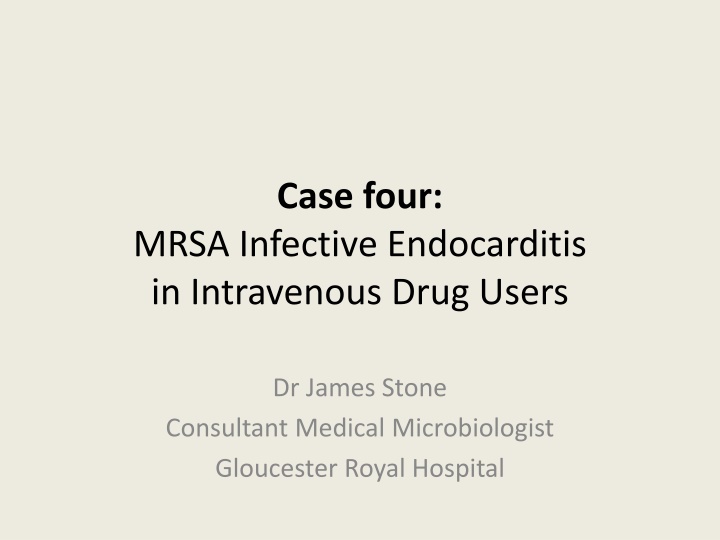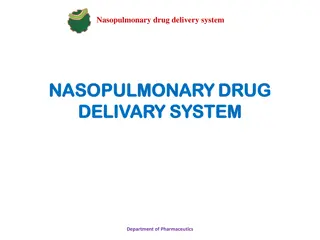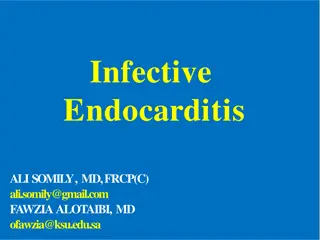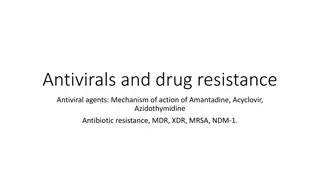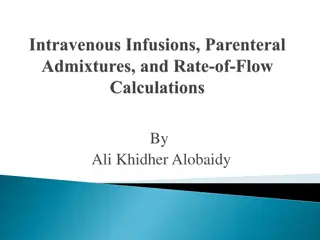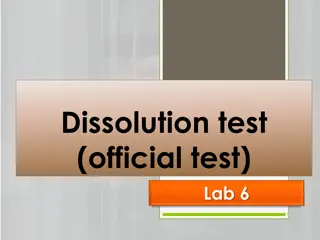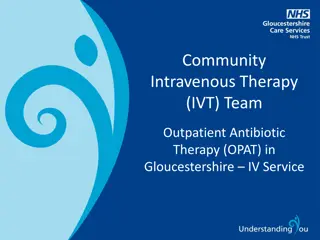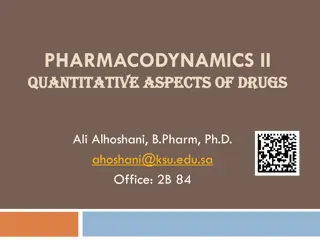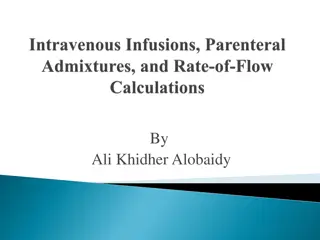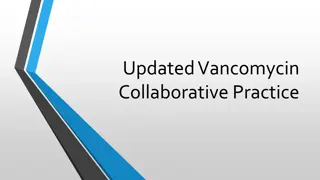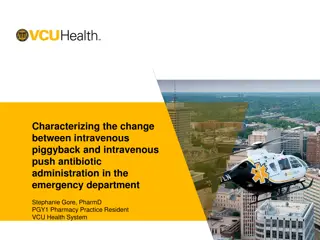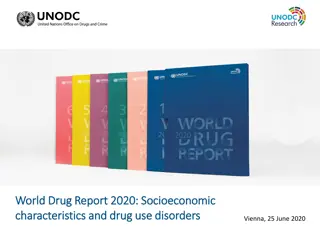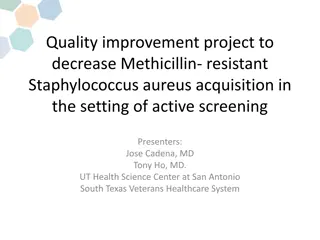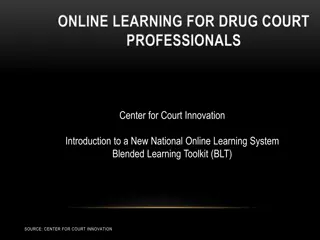MRSA Infective Endocarditis in Intravenous Drug Users
MRSA infective endocarditis cases in intravenous drug users, with a focus on treatment strategies, potential cross-infection risks, MRSA strain typing, and interventions to reduce infection risk in high-risk populations. Discussion includes the involvement of Drug Liaison Team for compliance assistance and future management.
Uploaded on Mar 01, 2025 | 0 Views
Download Presentation

Please find below an Image/Link to download the presentation.
The content on the website is provided AS IS for your information and personal use only. It may not be sold, licensed, or shared on other websites without obtaining consent from the author.If you encounter any issues during the download, it is possible that the publisher has removed the file from their server.
You are allowed to download the files provided on this website for personal or commercial use, subject to the condition that they are used lawfully. All files are the property of their respective owners.
The content on the website is provided AS IS for your information and personal use only. It may not be sold, licensed, or shared on other websites without obtaining consent from the author.
E N D
Presentation Transcript
Case four: MRSA Infective Endocarditis in Intravenous Drug Users Dr James Stone Consultant Medical Microbiologist Gloucester Royal Hospital
BACKGROUND Three IVDU patients diagnosed with infective endocarditis within less than 6 months (February, April and June 2018) All were actively taking intravenous drugs at time of diagnosis Two patients deceased (female aged 37 and second female aged 44). Male aged 39 survived. All had positive blood cultures with MRSA All (ultimately) received intravenous antimicrobial therapy with activity against the MRSA strains isolated Range of complications related to the infections
POINTS FOR DISCUSSION Treatment of MRSA infective endocarditis in a non- compliant IVDU patient Efficacy of intravenous v oral antimicrobial therapy in MRSA endocarditis Possible cross-infection in community or hospital? Value (or otherwise) of typing MRSA strains Relative virulence of different strains of MRSA and their propensity to cause infective endocarditis Screening for MRSA in high-risk populations such as IVDUs and role of interventions (if any) to reduce risk of infection in this population group. Importance of involving Drug Liaison Team to assist with compliance and future management.
CASE - 1 44 year old female Presented 13thApril 2018 Admitted via A&E with left-sided neck pain radiating into left hand side and chest. Known IVDU using neck for venous access. Also suffering from frequency and dysuria.
Case 1: Past Medical History IVDU previous MRSA bacteraemia August 2015 and August 2016. Abscesses (multiple) groin and leg from injections. DVT s - on Rivaroxaban Leg ulcers Previously treated for Infective Endocarditis with MRSA (August 2015). Did not undergo cardiac surgery. Known Hepatitis C + ve Previous lumbar spine abscess MRSA colonised (in the past) current MRSA screen status awaited following swabs being taken on admission Peripheral Neuropathy Asthma Fractured Skull Sciatica since spine abscess Bronchitis.
Case 1: Progress following admission Cannula inserted into right upper arm, replaced with central line inserted into right internal jugular vein in theatre the next day (14.04.18). Screened for MRSA colonisation (nose and groin). Leg ulcers (to both legs) not screened until 15.04.18 (2 days after admission). Absconded from ward following insertion of CVC and returned having clearly taken iv drugs. Antibiotic therapy with Co-amoxiclav given.
Case 1: Progress - continued 15.04.18 = Raised temperature 38.6. Neck pain left sided, tender to touch. No evidence of deep abscess/collection on CT scan. Absconded again. Returned to ward. Became unresponsive. Naloxone infusion and observations performed. Thought to be opioid narcosis. Diagnosis at this stage: Strong possibility of deep seated infection ? infective endocarditis. Neck swelling and pain could represent pyomyositis.
What would you do next? Investigations? Treatment?
Investigations Performed Multiple blood cultures Echocardiogram MRI
Case 1: Progress - continued Blood cultures taken (multiple sets) Co-amoxiclav continued. Echocardiogram arranged MRI spine booked for 17.04.18
Case 1: Progress - continued MRI: No evidence of discitis or vertebral osteomyelitis (although commented that there was multi-level disc disease . CVC - line removed (repeated absconding and using for self-administration of opiates).
What would you do next? Further investigations? Change to antimicrobial therapy?
Case 1: Progress - continued 17.04.2018: Increasingly drowsy. Heart rate 86. BP 94/50mmHg. Sats 90% on air (refused oxygen). Temp 35.2 C. Antimicrobial therapy changed to: Daptomycin 700mg/day iv but issues with administration following line removal Clindamycin 450mg qds oral Amoxicillin 1g qds oral Hibiscrub and Naseptin commenced (no Bactroban available national shortage) Leg ulcer swabs reported as being MRSA positive CRP 159. WCC 5.2.
Case 1: Progress - continued 18.04.18: Transthoracic Echocardiogram = No obvious SBE (Refused TOE) Again absconded from ward. On return admitted to using iv drugs and smoked 3 bags heroin. Left-sided neck lump (3cm x 3cm) developed with pus pointing at needle entry point Multiple blood cultures positive: MRSA and Streptococcus parasanguinis from all bottles USS of neck booked.
Case 1: Progress - continued Patient non-compliant with antimicrobial therapy. Accepted single dose of iv Dalbavancin (Microbiologist suggested 4 to 6 weeks of weekly Dalbavancin at 1.5g/week and to add oral co-trimoxazole 960mg BD to Clindamycin). Refused further investigations and treatment. Self-discharged from ward. Later re-admitted. Clinically endocarditis had now developed (hepatosplenomegaly, new murmur, heart failure) but she refused further investigations or treatment (and considered to have capacity). Developed renal failure and the heart failure became more severe. Died. MRSA typing performed.
Case - 2 37 year old female Presented on 1stJune 2018 Admitted via Emergency Department Known IVDU heroin and cocaine Severely cachectic (weighed around 40kg) Feeling unwell for 5 days with central chest pain (pleuritic in nature) and increasing shortness of breath. No cough. Body pain all over . Lived alone in supported housing HR 85. BP 95/55 mmHg. No murmurs. Resp rate 19. Sats 97% on air. Inspiratory crackles bilaterally. Hypothermic (Temperature 34.7 C).
Case 2: Continued Initial diagnosis in ED: ? PE, ? Chest infection Investigations: Bloods (including blood cultures) ECG CXR Transferred to admitting medical team
Case 2: Continued CXR: Wedge-shaped infarct left mid-zone Multiple opacities in both lungs For CTPA and/or CT Chest Clinical Review by Medical Team: Loud systolic murmur (new), Slight hepatomegaly Bloods: WCC 17.8, Platelets 33, CRP 262. Alb 16. Creatinine 335, Urea 28.8. D-dimer 7324. Blood gases: acidotic. Lactate 1.2.
Case 2: Continued Revised differential diagnosis: Sepsis ? Bacterial endocarditis murmur and multifocal chest lesions AKI Thrombocytopaenia secondary to sepsis Needs: blood cultures x3 sets, iv antibiotics, ECHO, HIV/Hep-B and C IV Vancomycin (1g) and Gentamicin (1mg/kg) started
Case 2: Continued (day 2 2ndJune) Admitted to ward but then transferred to HDU Developed generalised severe abdominal pain mesenteric infarction considered likely Lactate increased to 14. Echocardiogram: Very large vegetation on tricuspid valve Transfer advised to cardiac centre Blood cultures: Staphylococcus aureus (sensitivities pending) result telephoned. Hepatitis-C positive. Vancomycin (1g od) and gentamicin (40mg od 1mg/kg) to continue. Discharging abscess noted overlying right MTPJ Rifampicin added
Case 2: Continued (day 3) Staphylococcus aureus isolated from blood cultures identified as MRSA sensitive to vancomycin, gentamicin and rifampicin. Suggestion by microbiologist to consider adding rifampicin to current therapy with vancomycin and gentamicin. Staphylococcus aureus also isolated from MPTJ pus (subsequently identified as MRSA). Observations getting worse: Resp rate 24, sats 94% on 4L. Capillary refill 5sec. But: HR 92 and BP 112/70. Later: increasing oxygen requirements to maintain saturations. GCS fallen to 14. Resp rate increasing further to 35/min.
Case 2: continued (day 4) Rapid deterioration during the day hypoxic (on 15L), hypotensive, deteriorating renal function - became anuric, ventilated. Cardiothoracic team contacted decided not to pursue operative approach. Deceased MRSA sent for typing
Case-3 39 year old male Presented on 23rdFebruary 2018 Admitted via Emergency Department Known IVDU (heroin) Injecting into right groin Noticed red rash and strange feeling in right leg Swelling of right leg Weight loss of 1stover last 3 months Recent prison term and mental health issues
Case 3: continued On examination: Emaciated Hole in right groin - groin hard, tender but no redness or pus. Petechial rash on right leg. Right calf oedema. Observations: Resp rate 14, Sats 98.1% on air, BP 110/60, HR 75. Temp 36.4. Chest clear. No splinter haemorrhages/murmurs/splenomegaly CRP 300 Initially given stat dose of Co-amoxiclav 1.2g iv in the ED
Case 3: continued Blood cultures taken 3 sets Leg USS and Echocardiogram booked Flucloxacillin 1g qds started Co-amoxicillin stopped Provisional diagnosis: cellulitis Note: Need to rule out DVT and SBE
Case 3: continued What antimicrobial therapy would you consider giving at this stage? Any further investigations? Patient temporarily absconds from ward but returns in the evening. How might this behaviour influence your management plan? (He missed USS of leg and Echocardiogram)
Case 3: continued (24thFebruary Day 2) Blood cultures (provisional result telephoned 11:20am): Gram positive cocci in all bottles, look like staphylococci. Discussion with medical microbiologist: Start iv Daptomycin od Previous results reviewed - indicate known screening test positive for MRSA in previous year but not clinically infected t that point Clinically more unwell: BP falling (95/60), Resp rate increasing (18) Splinter haemorrhages right thumb and middle finger Increasing pain right leg
Case 3: continued Would you consider daptomycin monotherapy as reasonable at this stage? Given previous positive screening tests for MRSA, what else would you do at this point?
Case 3: continued (25thFebruary Day 3) Staphylococcus aureus in blood cultures identified as MRSA Weight loss now checked and would appear to be up to 2st in last few weeks (now 48kg) Echo and USS re-booked Daptomycin as monotherapy continued Spike in fever to 39.7 C BP fallen to 95/54 mmHg. HR 96
Case 3: continued Given spike in fever and clinical deterioration, would you consider adding any additional antimicrobial agent(s) at this stage? What dose of Daptomycin would be appropriate for an individual with a weight of 48kg and a potential infective endocarditis with MRSA? Any further investigations?
Case 3: continued He was continued on iv daptomycin at a dose of 350mg/day, giving a dose of 7.3mg/kg/day.
Case 3: continued (26thFebruary Day 4) Echocardiogram: No obvious SBE from views obtained. AV and PV not well seen USS: Abscess right groin (now starting to discharge) Infection Control Team: Needs MRSA decolonisation therapy Daptomycin continued Microbiologist comment: Treat as intravascular infection +/- IE. For 4 weeks of IV Daptomycin if possible (assess suitability for OPAT given IVDU history). Take swab from discharging groin sinus
Case 3: continued (Day 11) Referred to Drug Liaison Team Initially some improvement from day 4. Planning for discharge home Then: CXR: Patchy consolidation ? Cavitating lesions Persistent cough Temp spike to 38.6 C BP fall to 95/51
Case 3: continued What is you differential list of diagnoses at this stage? What investigations would you consider appropriate? How may you antimicrobial therapy recommendations change? (e.g. questionable efficacy of Daptomycin in treatment of staphylococcal lower respiratory tract infection?)
Case 3: continued The medical team in fact added oral co- amoxiclav 625mg tds orally on day 11 (reported indication given on the drug chart for this was infected groin wound ). It was continued for 10 days.
Case 3: continued (day 12) Medical Team Differential Diagnosis: ? TB ? Vasculitic infection Plan: Sputum culture (including for TB) T-spot CT Thorax Respiratory referral
Case 3: continued (Day 13) CT scan: Multiple bilateral cavitating lung lesions Bloods: CRP fallen steadily from 300 on admission to 89. WCC: 8.5 (was 12.0 on admission) Right groin decreasing discharge IV Daptomycin continued
Case 3: continued (Day 18) T-spot positive Awaiting TB sputum culture but AAFB smear ve BCG scar present Awaiting TOE (previous echocardiogram was TTE)
Case 3: continued (outcome) Completed 6 weeks of iv daptomycin as an inpatient TOE was ultimately not done, therefore uncertain as to whether he actually had IE Lung lesions slowly resolved ?Latent TB was not treated. Sputum was culture negative In late July 2018 he had a recurrence of his groin abscess which grew MRSA again but was treated successfully with Daptomycin MRSA sent for typing.
TYPING RESULTS FOR MRSA ISOLATES (as of August 2018) Case 1: MRSA typing: MLST Allelic Profile: 1,4,1,4,12,1,10 Case 2: MRSA typing: MLST Allelic Profile: 1,4,1,4,12,1,10 (same as case 1) Case 3: MRSA typing: MLST Allelic Profile: 1,4,2,4,12,1,10 BUT: Genotyping suggested strains were different.
TYPING RESULTS FOR MRSA ISOLATES: UPDATE OCTOBER Case 1: MRSA typing: MLST Allelic Profile: 1,4,1,4,12,1,10 Case 2: MRSA typing: MLST Allelic Profile: 1,4,1,4,12,1,10 (same as case 1) Case 3: MRSA typing: MLST Allelic Profile: 1,4,2 (re- reported as 1),4,12,1,10 Case 4 (14/07/2018): Profile as above Case 5 (13/09/2018): Profile as above Case 6 (24/09/2018): Profile as above (Note, last 3 cases are all bacteraemias but not all confirmed as having endocarditis currently)
POINTS FOR DISCUSSION Treatment of MRSA infective endocarditis in a non- compliant IVDU patient Efficacy of intravenous v oral antimicrobial therapy in MRSA endocarditis Possible cross-infection in community or hospital? Value (or otherwise) of typing MRSA strains Relative virulence of different strains of MRSA and their propensity to cause infective endocarditis Screening for MRSA in high-risk populations such as IVDUs and role of interventions (if any) to reduce risk of infection in this population group. Importance of involving Drug Liaison Team to assist with compliance and future management.
